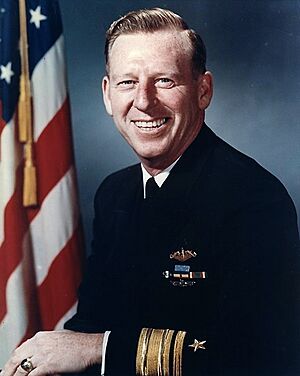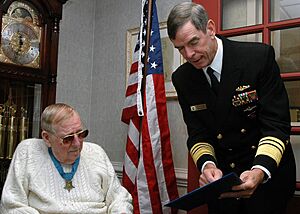Eugene B. Fluckey facts for kids
Quick facts for kids
Eugene Bennett Fluckey
|
|
|---|---|
 |
|
| Nickname(s) | Lucky |
| Born | October 5, 1913 Washington, D.C. |
| Died | June 28, 2007 (aged 93) Annapolis, Maryland |
| Place of burial |
United States Naval Academy Cemetery
|
| Allegiance | United States of America |
| Service/ |
|
| Years of service | 1935–1972 |
| Rank | Rear admiral |
| Commands held |
|
| Battles/wars | World War II
|
| Awards | Medal of Honor Navy Cross (4) Navy Distinguished Service Medal (2) Legion of Merit (2) |
| Other work | Orphanage Director, Portugal |
Eugene Bennett Fluckey (born October 5, 1913 – died June 28, 2007) was a brave United States Navy officer. He was known as "Lucky Fluckey" because of his amazing skill and good fortune. He became a rear admiral and earned the highest military award, the Medal of Honor. He also received four Navy Crosses for his heroic actions as a submarine commander during World War II.
Contents
Early Life and Education
Eugene Fluckey was born in Washington, D.C., on October 5, 1913. He was a very smart student and finished Western High School when he was just 15 years old. Since he was too young for college, his father sent him to the Mercersburg Academy in Mercersburg, Pennsylvania. He was also an Eagle Scout, which is the highest rank in the Boy Scouts of America. This experience helped him later in his Navy career.
Fluckey began his journey at the United States Naval Academy on June 13, 1931. He graduated and became a junior officer, an Ensign, on June 6, 1935. His first jobs in the Navy were on a battleship called USS Nevada (BB-36). Later, in 1936, he moved to a destroyer named USS McCormick (DD-223).
In 1938, he started special training at the Submarine School in New London, Connecticut. After finishing his training, he served on two submarines: USS S-42 (SS-153) and USS Bonita (SS-165).
Heroic Actions in World War II
During World War II, Eugene Fluckey completed five war patrols on the submarine Bonita. After that, he went back to Annapolis for more training in naval engineering. In 1944, he attended a special school to become a submarine commander.
He then joined the submarine USS Barb (SS-220). In January 1944, he became the commander of the Barb. Fluckey quickly became known as one of the best submarine commanders. He was credited with sinking a huge amount of enemy ships, including a carrier, a cruiser, and a frigate. In total, he helped sink 25 ships, which was the second-highest amount by a U.S. Naval commander in World War II.
The Famous Train Attack
One of the most amazing things Fluckey did was during a mission on Sakhalin Island. This island was part of Japan at the time. He sent a small group of his crew ashore to blow up a railway line. This was the only time U.S. military forces landed on the main Japanese islands during World War II.
Fluckey carefully chose an eight-man team for this dangerous mission. He picked crewmen from every part of his submarine. He also made sure no one on the team was married. He even preferred former Boy Scouts, thinking they would be good at finding their way back. The team successfully set explosives under the rails. As they paddled back to the submarine, the 16-car train blew up!
Revolutionizing Submarine Warfare
Fluckey received four Navy Crosses for his incredible bravery during several of Barb's war patrols. During his eleventh patrol, he changed how submarines fought. He found new ways to attack enemy convoys (groups of ships) at night. He would sneak up from behind their protective escort ships.
He even attacked two convoys that were anchored in shallow coastal waters off the China coast. There were more than 30 ships in total. With two enemy frigates chasing them, the Barb pushed its engines to the limit. It set a world speed record for a submarine at the time, reaching 23.5 knots (44 km/h). For his amazing courage and daring, Fluckey was awarded the Medal of Honor. The Barb also received a special award called the Presidential Unit Citation for its outstanding performance.
After the War
After World War II ended in 1945, Fluckey continued to serve in the Navy. He worked on important plans for combining the different branches of the armed forces. He also became a personal aide to Fleet Admiral Chester W. Nimitz, a very important Navy leader.
In 1947, he returned to submarines and commanded the USS Halfbeak (SS-352). This submarine was one of the first to be updated with new technology, like a snorkel, to make it faster underwater.
From 1950 to 1953, he worked as a U.S. Naval Attaché in Portugal. This meant he represented the U.S. Navy there. The Portuguese government even gave him a special award for his excellent service. Fluckey continued to hold important commands, including leading a submarine flotilla and teaching at the Naval Academy.
In 1960, he was promoted to Rear admiral. He then commanded Amphibious Group 4 and later became the Director of Naval Intelligence. He retired from active duty as a Rear admiral in 1972.
Retirement and Later Life
After retiring from the Navy in 1972, Eugene Fluckey and his wife, Marjorie, moved to Portugal. There, they started running an orphanage in 1974, helping children in need. Marjorie passed away in 1979. In 1980, he married his second wife, Margaret, and they continued to run the orphanage until it closed in 1982. He had one daughter, Barbara.
In 1992, Fluckey wrote a book called Thunder Below!. It tells the exciting stories of his beloved submarine, the Barb. He wrote that even though the Barb faced many attacks, no one on board ever received a Purple Heart medal for being wounded. The Barb always came back ready to fight again.
Eugene Fluckey passed away on June 28, 2007, at the age of 93. He is buried at the United States Naval Academy Cemetery.
Military Awards and Honors
Eugene Fluckey received many awards for his bravery and service:
- Medal of Honor (the highest military award)
- Four Navy Crosses
- Two Navy Distinguished Service Medals
- Two Legion of Merit medals
- Presidential Unit Citation
- Navy Unit Commendation
- American Defense Service Medal
- American Campaign Medal
- Asiatic-Pacific Campaign Medal
- World War II Victory Medal
- National Defense Service Medal
- Philippine Liberation Medal
- Navy Pistol Marksmanship Medal
He was also an Eagle Scout. He is one of only eleven known Eagle Scouts who also received the Medal of Honor, which is a very rare and special achievement. His book, Thunder Below!, also won the 1993 Samuel Eliot Morison Award for Naval Literature.
See also


